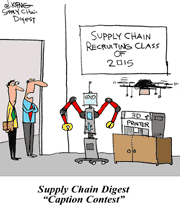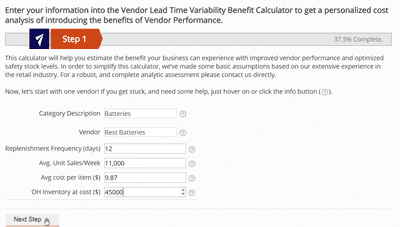 |
February 6, 2015 - Supply Chain Flagship Newsletter |
 |
| FEATURED SPONSOR: AMBER ROAD |
||
 |
||
|
||
 |
|
|||||||||||||||||||||||||||||||||||||||||||||||||||||||||||||||||||||||||||||||||||||||||
Gartner starts by noting that while robots have been around for decades in manufacturing operations, the use of robots in distribution centers has been limited by the typical architecture of industrial robots (though a few companies are using robots for automated palletization at the end of sorter diverts). Industrial robots are typically large, heavy and designed to do specific tasks (such as welding or assembly) and are in fixed locations. However, "New types of robotics are emerging to address the limitations of complex automated warehouses of the past and are advanced evolutions of previous generations of automated guided vehicles (AGVs)," Gartner says. It adds that "While commercial adoption will remain low, warehouse robots will evolve rapidly during the next five years to address some limitations of previous generations of automation." That includes lower costs, flexibility to perform multiple tasks, and improved "intelligence," where the robots might communicate with each other to get the work done most efficiently. I'll note that of course there are several types of robots for DCs, including the palletizers referenced above (which themselves are getting more flexible), the AGV-type machines (most notably instantiated in what are now Amazon's Kiva System robots), and potential humanoid type robots such as Rethink Robotics' Baxter unit that might be able to do order packing, kitting and maybe someday split case picking. Gartner adds that "Although warehouse robots will gain traction in complex distribution centers, the same technologies will have applications outside warehouses as the technology matures. For example, in retail stores, there is the potential in the not-too-distant future that robots will be able to unload trucks and deliver pallets of goods to specific departments in a store, without human intervention." On the supply chain sides, Garter predicts that "By 2018, 40% of all manufacturing companies will have a chartered demand planning organization that is tasked with creating demand forecasts and demand plans." Don't most companies have such an organization today? I sure thought so, but maybe not. Regardless, the discussion is interesting. Gartner notes that "The move toward becoming demand-driven is forcing companies to re-evaluate their approach to managing demand. There is a shift toward extending the time horizon of demand plan development from three to six months to 12 to 24 months for many companies." Gartner says many companies still rely heavily on forecasts from commercial and finance teams to try to develop the demand signals that are sent to supply planning and manufacturing - but are finding that they are ill-equipped to forecast true marketplace demand and have difficulty accurately identifying what product is needed in which location to meet customer demand (that is, forecasting at SKU-location level). It adds that "While many companies are embarking on S&OP planning initiatives to try to collaborate and tune their demand signal, they find that their forecasting methods are woefully inadequate to provide a suitable input into S&OP." It also says that while demand planning software vendors are making important strides in capabilities, "As companies continue to implement and leverage these features, those without focused demand planning groups will find that they are ill-equipped to take full advantage of the software features." As more companies strive to improve supply chain responsiveness, they are looking to utilize demand-sensing capabilities to drive more accurate and more granular short-term signals to supply planning and manufacturing, Gartner argues. In terms of predictions for chief supply chain officers, not such good news, as Gartner says "Fifty percent of today's senior supply chain executives will turn over by 2018 due to misalignment between leadership skills and supply chain maturity." Yikes! That seems high - 50% gone in three years? Gartner argues that "Traditionally, supply chain executives have been successful because they were good at driving down costs. Now, they will be judged on cost containment and the ability to promote and support the top line." That shift - along with the need to rapidly "digitize" supply chains and rethink process models on a global basis - means many CSCOs simply will not be able to keep up. It also recommends CSCOs work to establish tighter connections to the CIO to get more aligned with IT. In its supply chain predictions for 2015, the analysts at IDC Manufacturing Insights say that by 2016, 70% of global discrete manufacturers will offer smart connected products, driving the need for new digital supply chain capabilities. Ok, this is internet of Things stuff, and no question we are soon going to have billions of connected devices, machines, etc. But IDC smartly recognizes some of the real challenges here: Who owns this digital supply chain? The supply chain organization itself? A partnership between supply chain, IT, and maybe even marketing? Ownership of the digital supply chain will be a critical question, and IDC notes that for a manufacturer that has historically managed physical supply chains, this digital supply chain is scary stuff indeed. "This automation of products increases the need to have a unified, global product development system that can manage mechanical, electrical, and software information for all engineering domains - and a supply chain that can deliver these products," IDC says. IDC also predicts that by 2017, 50% of manufacturers will explore the viability of "micro-logistics" networks to enable the promise of accelerated delivery for select products and customers. IDC's Simon Ellis writes that "One of the consequences of increasing customer centricity, and the reality of reducing order lead times, is that the traditional large, regional distribution center may have seen its peak. While we do not believe there isn't a role for the 1 million square foot facility, we are expecting that manufacturers will begin to explore smaller, local warehouses that will make up a micro-logistics network. This will not be a trivial undertaking, and it may be implemented in various ways, including partnering with large logistics service providers, but it seems to be an inevitable result of accelerated delivery, particularly if direct to consumer grows as a practical channel." Ok, that's enough for here. I just scratched the surface of these analyst predictions - we'll provide some additional detail in next week's OnTarget newsletter. Any reaction to these 2015 supply chain analysts predictions? Have any predictions of your own you can share? Do you think 50% of current supply chain executives will be gone by 2015? Let us know your thoughts at the Feedback button or section below. |
||||||||||||||||||||||||||||||||||||||||||||||||||||||||||||||||||||||||||||||||||||||||||
|
||||||||||||||||||||||||||||||||||||||||||||||||||||||||||||||||||||||||||||||||||||||||||
|
||||||||||||||||||||||||||||||||||||||||||||||||||||||||||||||||||||||||||||||||||||||||||
|
|
|
YOUR FEEDBACK
As promised, more emails from our First Thoughts piece on What Would You Tell Accountants about Supply Chain? Parts 1 and 2.
There were such a number of good ones, we are again not going to select a Feedback of the Week, but will rather just publish a few of the better ones thins week and next.
Feedback on What Would You Tell Accountants about Supply Chain?:
In 2013, I gave a talk to the Illinois CPA Society on inventory. I asked myself the same question that you did - how in my case can I make inventory interesting to CPA's and what should I suggest they do to influence it. |
||
I've been using a version of the DuPont model since the seventies. The version I was exposed to was called the Strategic Profit Model (SPM), but it is the same thing. I believe I was first exposed to it in a seminar put on by Dr. Bud LaLonde of Ohio State. To me, it is one of the most valuable tools around, both for finance people and for those of us in supply chain.
To an extent, I've had similar experiences to yours where I got a lot of blank stares from finance people. When I asked if they were familiar with the model, many have indicated they were unaware of it. I think one of the problems, is that the model has typically been presented as a generic model, showing relationships, but void of any data. That makes it abstract. However, when you load it with real data, the financial picture of organizations comes into view in an easily comprehensible way. In one company I worked for, we shared detailed financial information with all of our employees. Using the SPM, we not only shared the data with the employees, but they were able to track their individual job/work efforts all the way to Net Profit and ROI. They got it!
David Armstrong
|
SUPPLY CHAIN TRIVIA ANSWER
Q: The new largest container ship on the waters — the CSCL Globe — can carry 19,000 TEU. How many miles would it stretch if all those containers were placed end-to-end?
A: An astounding 72 miles. No wonder ports are congested.
| © SupplyChainDigest™ 2003-2015. All Rights Reserved. SupplyChainDigest PO Box 714 Springboro, Ohio 45066 |
POWERED BY: XDIMENSION
|









